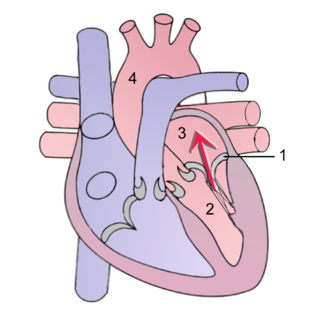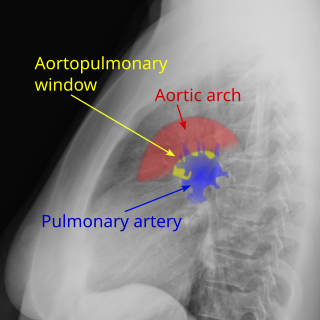Related Research Articles

The stethoscope is a medical device for auscultation, or listening to internal sounds of an animal or human body. It typically has a small disc-shaped resonator that is placed against the skin, with either one or two tubes connected to two earpieces. A stethoscope can be used to listen to the sounds made by the heart, lungs or intestines, as well as blood flow in arteries and veins. In combination with a manual sphygmomanometer, it is commonly used when measuring blood pressure.

Aortic stenosis is the narrowing of the exit of the left ventricle of the heart, such that problems result. It may occur at the aortic valve as well as above and below this level. It typically gets worse over time. Symptoms often come on gradually with a decreased ability to exercise often occurring first. If heart failure, loss of consciousness, or heart related chest pain occur due to AS the outcomes are worse. Loss of consciousness typically occurs with standing or exercising. Signs of heart failure include shortness of breath especially when lying down, at night, or with exercise, and swelling of the legs. Thickening of the valve without causing obstruction is known as aortic sclerosis.

Heart sounds are the noises generated by the beating heart and the resultant flow of blood through it. Specifically, the sounds reflect the turbulence created when the heart valves snap shut. In cardiac auscultation, an examiner may use a stethoscope to listen for these unique and distinct sounds that provide important auditory data regarding the condition of the heart.

Heart murmurs are unique heart sounds produced when blood flows across a heart valve or blood vessel. This occurs when turbulent blood flow creates a sound loud enough to hear with a stethoscope. Turbulent blood flow is not smooth. The sound differs from normal heart sounds by their characteristics. For example, heart murmurs may have a distinct pitch, duration and timing. The major way health care providers examine the heart on physical exam is heart auscultation; another clinical technique is palpation, which can detect by touch when such turbulence causes the vibrations called cardiac thrill. A murmur is a sign found during the cardiac exam. Murmurs are of various types and are important in the detection of cardiac and valvular pathologies.

Korotkoff sounds are the sounds that medical personnel listen for when they are taking blood pressure using a non-invasive procedure. They are named after Nikolai Korotkov, a Russian physician who discovered them in 1905, when he was working at the Imperial Medical Academy in St. Petersburg, the Russian Empire.

Mitral valve prolapse (MVP) is a valvular heart disease characterized by the displacement of an abnormally thickened mitral valve leaflet into the left atrium during systole. It is the primary form of myxomatous degeneration of the valve. There are various types of MVP, broadly classified as classic and nonclassic. In severe cases of classic MVP, complications include mitral regurgitation, infective endocarditis, congestive heart failure, and, in rare circumstances, cardiac arrest.

Chest pain is pain or discomfort in the chest, typically the front of the chest. It may be described as sharp, dull, pressure, heaviness or squeezing. Associated symptoms may include pain in the shoulder, arm, upper abdomen, or jaw, along with nausea, sweating, or shortness of breath. It can be divided into heart-related and non-heart-related pain. Pain due to insufficient blood flow to the heart is also called angina pectoris. Those with diabetes or the elderly may have less clear symptoms.

Mitral stenosis is a valvular heart disease characterized by the narrowing of the opening of the mitral valve of the heart. It is almost always caused by rheumatic valvular heart disease. Normally, the mitral valve is about 5 cm2 during diastole. Any decrease in area below 2 cm2 causes mitral stenosis. Early diagnosis of mitral stenosis in pregnancy is very important as the heart cannot tolerate increased cardiac output demand as in the case of exercise and pregnancy. Atrial fibrillation is a common complication of resulting left atrial enlargement, which can lead to systemic thromboembolic complications such as stroke.

Mitral regurgitation (MR), also known as mitral insufficiency or mitral incompetence, is a form of valvular heart disease in which the mitral valve is insufficient and does not close properly when the heart pumps out blood. It is the abnormal leaking of blood backwards – regurgitation from the left ventricle, through the mitral valve, into the left atrium, when the left ventricle contracts. Mitral regurgitation is the most common form of valvular heart disease.
Venous hum is a benign auscultatory phenomenon caused by the normal flow of blood through the jugular veins. At rest, 20% of cardiac output flows to the brain via the internal carotid and vertebral arteries; this drains via the internal jugular veins. The rush of blood from these veins to the brachiocephalic vein can cause the vein walls to vibrate, creating a humming noise which can often be heard by the subject.

Valvular heart disease is any cardiovascular disease process involving one or more of the four valves of the heart. These conditions occur largely as a consequence of aging, but may also be the result of congenital (inborn) abnormalities or specific disease or physiologic processes including rheumatic heart disease and pregnancy.
A pericardial friction rub, also pericardial rub, is an audible medical sign used in the diagnosis of pericarditis. Upon auscultation, this sign is an extra heart sound of to-and-fro character, typically with three components, two systolic and one diastolic. It resembles the sound of squeaky leather and often is described as grating, scratching, or rasping. The sound seems very close to the ear and may seem louder than or may even mask the other heart sounds. The sound usually is best heard between the apex and sternum but may be widespread.
A functional murmur is a heart murmur that is primarily due to physiologic conditions outside the heart, as opposed to structural defects in the heart itself. Serious conditions can arise even in the absence of a primary heart defect, and it is possible for peripheral conditions to generate abnormalities in the heart. Therefore, caution should be applied to use of the terms "innocent" or "benign" in this context.Use of the term dates to the mid 19th century.
Still's murmur is a common type of benign or "innocent" functional heart murmur that is not associated with any sort of cardiac disorder or any other medical condition. It can occur at any age although it is most common among children two to seven years of age and it is rare in adulthood.

Aortopulmonary window (APW) is a faulty connection between the aorta and the main pulmonary artery that results in a significant left-to-right shunt. The aortopulmonary window is the rarest of septal defects, accounting for 0.15-0.6% of all congenital heart malformations. An aortopulmonary window can develop alone or in up to 50% of cases alongside other cardiac defects such as interrupted aortic arch, coarctation of the aorta, transposition of great vessels, and tetralogy of Fallot.

Hypertrophic cardiomyopathy screening is an assessment and testing to detect hypertrophic cardiomyopathy (HCM).
An isometric exercise device is a device used to exercise most body parts including the wrist and is often used as part of physical therapy or in order to build muscle strength in a low impact manner. Devices can range in size from large bulky machines used by physicians to small hand-held devices that can be used by an individual. Isometric devices have been used for centuries. The first devices did not display the users' output; nowadays there are devices that can digitally output the users force. Before that some devices used an analog format.
The cardiovascular examination is a portion of the physical examination that involves evaluation of the cardiovascular system. The exact contents of the examination will vary depending on the presenting complaint but a complete examination will involve the heart, lungs, belly and the blood vessels.
Computer-aided auscultation (CAA), or computerized assisted auscultation, is a digital form of auscultation. It includes the recording, visualization, storage, analysis and sharing of digital recordings of heart or lung sounds. The recordings are obtained using an electronic stethoscope or similarly suitable recording device. Computer-aided auscultation is designed to assist health care professionals who perform auscultation as part of their diagnostic process. Commercial CAA products are usually classified as clinical decision support systems that support medical professionals in making a diagnosis. As such they are medical devices and require certification or approval from a competent authority.
References
- ↑ Silverman ME, Wooley CF. Samuel A. Levine and the history of grading systolic murmurs. Am J Cardiol. 2008 Oct 15;102(8):1107-10.
- ↑ Orient JM (2010). "Chapter 17: The Heart". Sapira's Art & Science of Bedside Diagnosis (4th ed.). Philadelphia: Wolters Kluwers Health. p. 339. ISBN 978-1-60547-411-3.
- ↑ Freeman AR, Levine SA (1933). "Clinical significance of systolic murmurs: Study of 1000 consecutive "noncardiac" cases". Ann Intern Med. 6: 1371–1379. doi:10.7326/0003-4819-6-11-1371.
- ↑ "Medline Plus Medical Dictionary, definition of "cardiac thrill"".
- ↑ Keren Ron; Tereschuk Michele; Luan Xianqun (2005). "Evaluation of a Novel Method for Grading Heart Murmur Intensity". Arch Pediatr Adolesc Med. 159 (4): 329–334. doi: 10.1001/archpedi.159.4.329 .
- ↑ Heart Sounds Made Incredibly Easy!, Volume 1. Lippincott Williams & Wilkins, Oct 1, 2004; page 106.